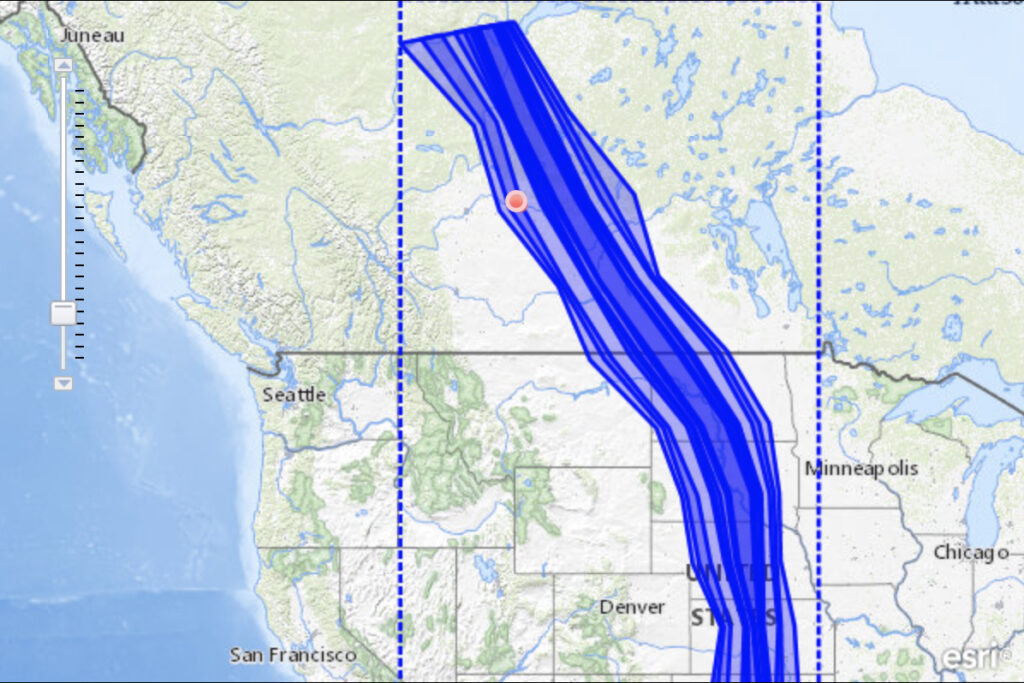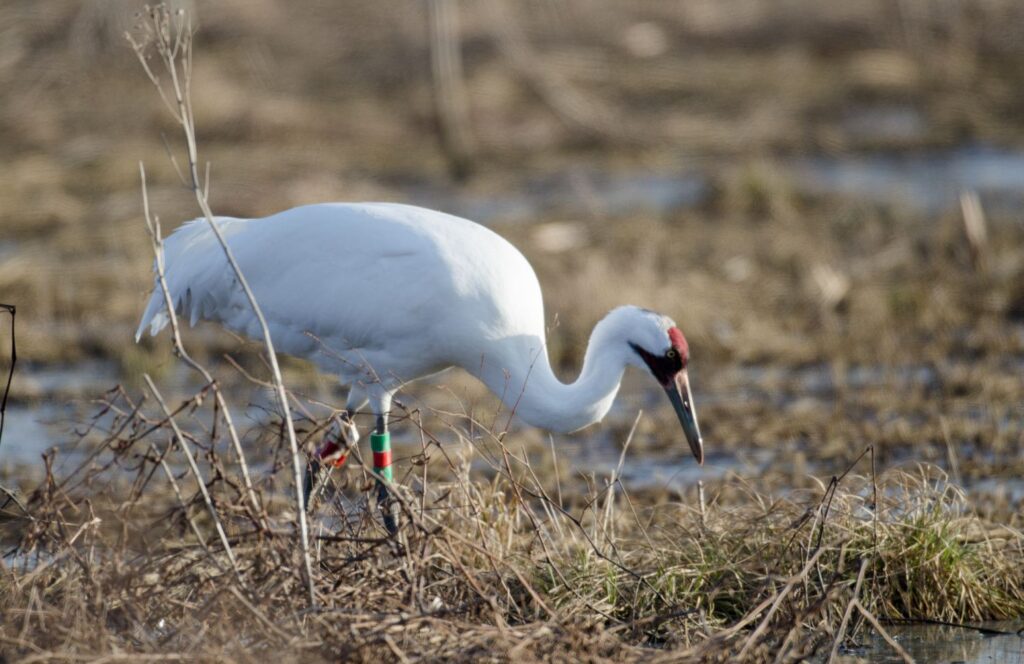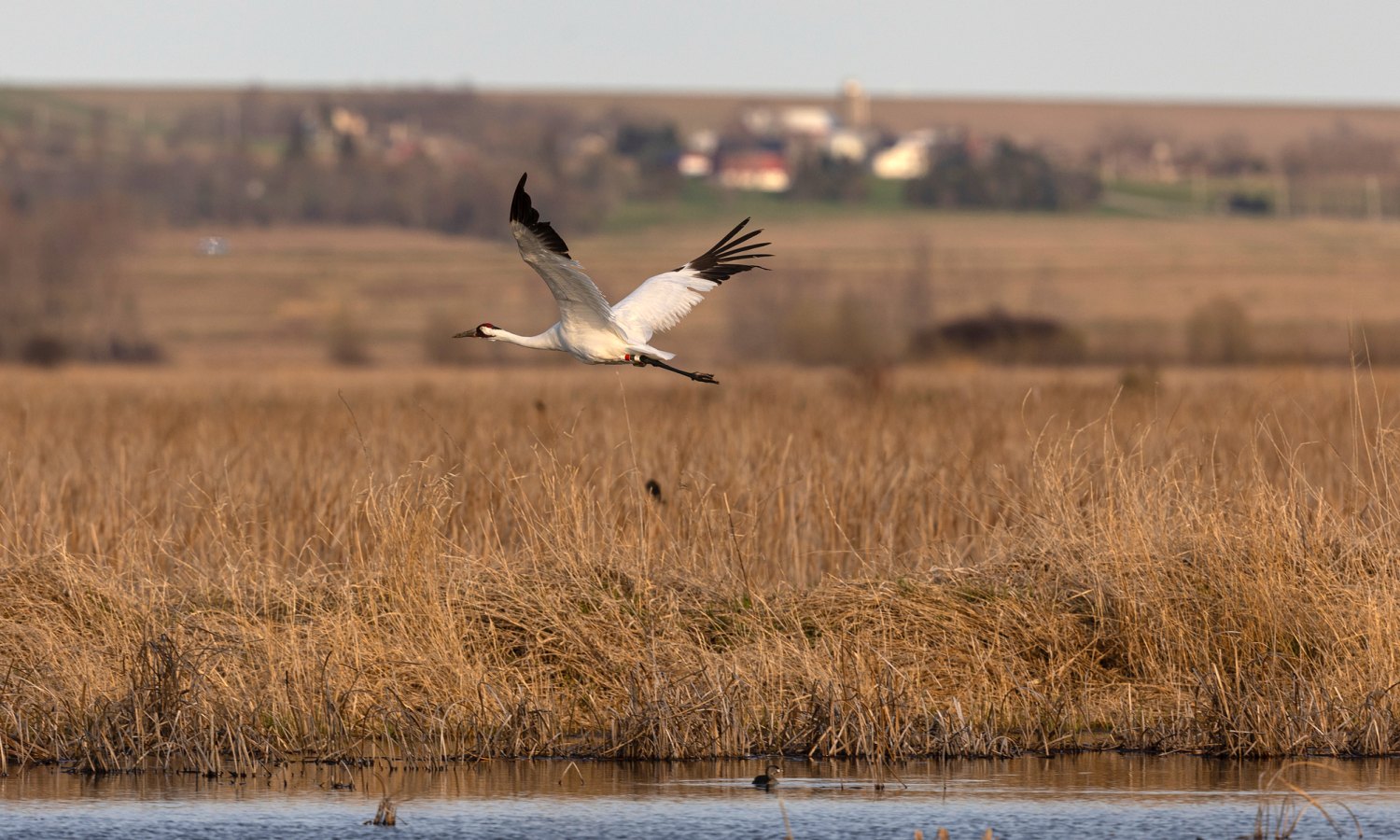Whooping Cranes not only migrate through the Elk Point, Alberta region, but they also use the Northern Valley as “summer grounds.” This, according to the latest telemetry data released to Wind Concerns by Environment Canada and Climate Change (ECCC) on April 5, 2023. It means that Vancouver-based Elemental Energy’s wind turbine project proposed for the Northern Valley would directly impact this endangered species.

“We already knew that the Northern Valley was on the western band of the Whooping Cranes’ migratory path,” says Wind Concerns founder, Mark Mallett, “but this new data shows they are actually using the proposed wind project area as summer grounds — I mean, right smack in the middle of it” (see map, right; red dot marks proposed wind project in the Northern Valley).1 Wildlife biologist, John Conkin of the Canadian Wildlife Service who provided the data, explains:
Summer grounds begins as soon as the bird stops displaying directional northward travel (i.e., it settles in an area and doesn’t continue further north). Summer use in prairie and parkland areas (south of their breeding range in and around Wood Buffalo National Park) is common for juvenile or sub adult bird (non-breeders). Often they will stay in those prairie or parkland areas throughout the summer (but travel widely) before showing direction southward migration in the fall.
April 5, 2023, email to Wind Concerns
According to the ECCC’s website:
To protect cranes from disturbance, human activities should be monitored, regulated, and/or prohibited wherever they have the potential to cause problems for the cranes.
2.7.3 Disturbance, canada.ca
In the study “Raptor Interactions With Wind Energy: Case Studies From Around the World,” its author states:
The global potential for wind power generation is vast, and the number of installations is increasing rapidly. We review case studies from around the world of the effects on raptors of wind-energy development. Collision mortality, displacement, and habitat loss have the potential to cause population-level effects, especially for species that are rare or endangered.
Richard T. Watson, 2018, bioone.org
Wind Concerns organized their first public meeting on April 4th to oppose the proposed wind turbine project in what Alberta Fish and Wildlife has declared a “Wildlife Sensitivity Zone.” The project also directly impacts the North Saskatchewan River, which is listed as a “Key Wildlife and Bio-diversity zone.”
According to the Species at Risk Act:
…no person shall destroy any part of the critical habitat of any listed endangered species or of any listed threatened species
Section 58 (1), laws-lois.justice.gc.ca
“We don’t know what Elemental Energy is thinking,” says Mallett. “Not only the cranes, but bald eagles and sharp-tailed grouse — listed as “sensitive” species by the province — live here (along with pelicans, vultures, Sand Cranes, and Blue Heron). This is the North Saskatchewan River and Lakeland region. We expect that the Alberta Government and its regulatory bodies will do the right thing and crush this environmentally damaging project very quickly. We don’t ‘save the environment’ by destroying it.”
In attendance at the packed town hall meeting was MLA Hon. David Hanson for the Bonnyville-Cold Lake-St. Paul constituency. He agrees that the proposed project is problematic:
You can’t have it both ways — you can’t have the province declare this a “Wildlife Sensitivity Zone” and a recognized migratory path for an endangered species — and then allow a project as potentially damaging as this.
Hon. David Hanson, April 4, 2023, Public Meeting held by Wind Concerns, Elk Point, AB
United Conservative Party nominee Scott Cyr also addressed the crowd, committing his support to defend the ecologically sensitive region.

to endangered Whooping Crane
According to the ECCC’s website, “The inherent capacity of Whooping Cranes to rebound demographically is low due to delayed sexual maturity (age 3–4 years) and a low reproductive rate (two eggs in the annual nesting attempt, with only one chick typically fledging).” Hence, American Bird Conservancy says, “The loss of even a few Whooping Cranes could result in a population-level effect.”2

“Ironically,” notes Mallett, “the Principal of Elemental Energy is Jamie Houssian, who is also on the Board of Directors3 of the Pembina Institute — the very same thinktank that has lamented the possible demise of the Whooping Crane due to the oilsands.4 The question now is whether Mr. Houssian will apply the same standards to his wind project that unquestionably will put these and other species at risk — and cancel it.”
Wind turbines kill as many as 1.17 million birds a year in the U.S. alone, according to several studies.5 They are also increasingly robbing precious habitat of the Whooping Crane. “We now know that too many of these turbines are eliminating important migratory stopover habitat for this Endangered species,” said Joel Merriman of American Bird Conservancy (see A Whooping Big Deal).6
A year ago, a U.S. wind energy company was ordered to pay $8m in fines after pleading guilty to killing at least 150 bald and golden eagles at its wind farms.7 They were charged under the Migratory Bird Treaty Act, which Canada has signed onto.
Whooping cranes are assessed as endangered by the Committee on the Status of Endangered Wildlife in Canada and are protected under the Species at Risk Act. Canada Wildlife Service has a 24-hour hotline where sightings can be reported: 306-975-5595.
For more information or to interview Mark Mallett, contact Wind Concerns at:
[email protected].
- Reproduced and distributed with the permission of Environment and Climate Change Canada. This article has been produced by Wind Concerns and includes data provided by Environment and Climate Change Canada. The incorporation of data sourced from Environment and Climate Change Canada within this article shall not be construed as constituting an endorsement by Environment and Climate Change Canada of our article.[↩]
- Letter: “Revival of the Poorly-sited Merricourt Wind Energy Project in North Dakota”, November 17, 2014[↩]
- cf. pembina.org[↩]
- cf. pembina.org/media-release/1739 and pembina.org/reports/borealbirdsreport.pdf[↩]
- abcbirds.org[↩]
- April 1, 2021; ESA[↩]
- cf. The Guardian, April 11, 2022[↩]
Mark Mallett is a former award-winning reporter with CTV Edmonton and an independent researcher and author. His family homesteaded between Vermilion and Cold Lake, Alberta, and now resides in the Lakeland region. Mark is Editor in Chief of Wind Concerns.


